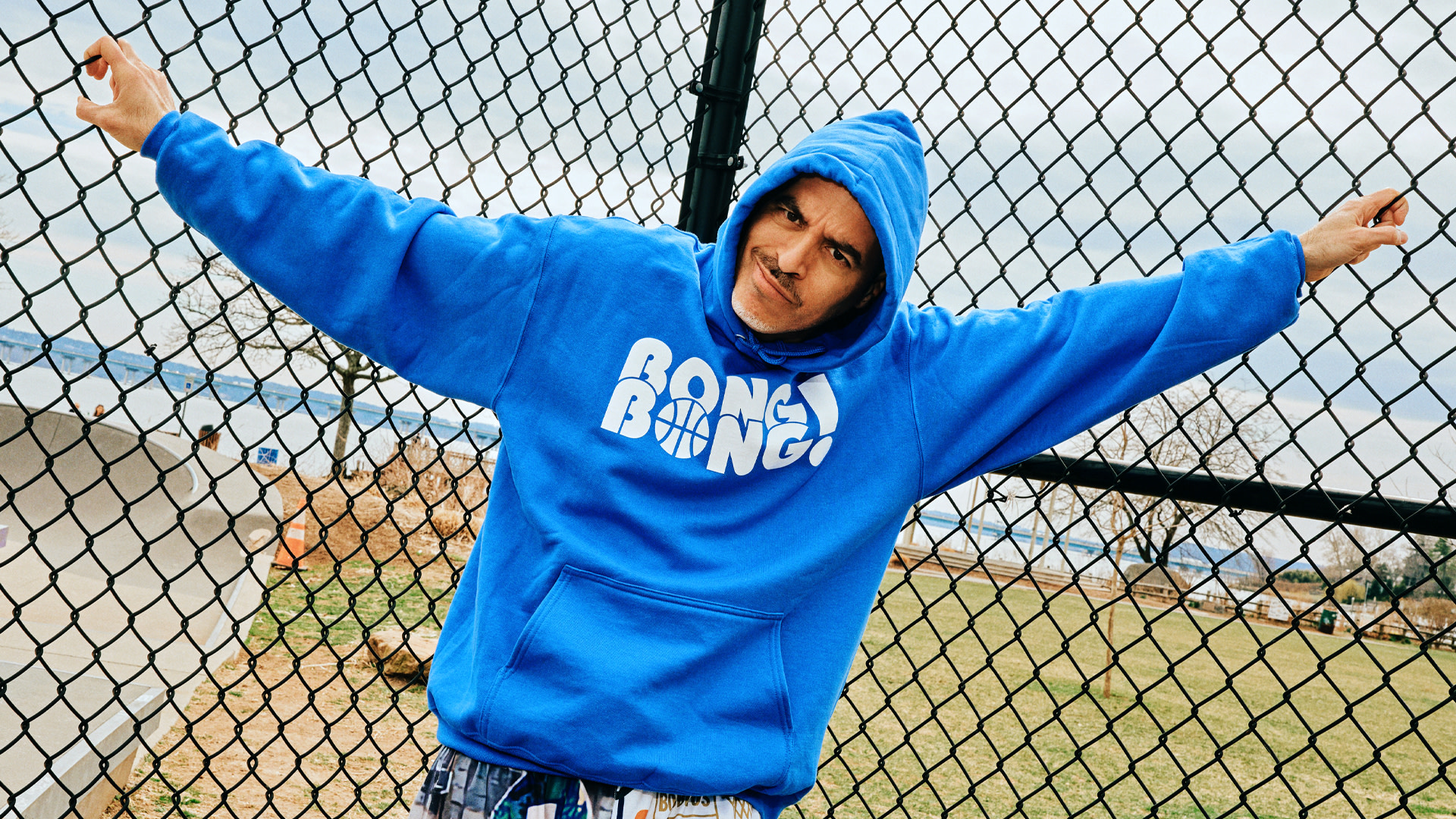Bobbito García’s face beams through my laptop screen, framed by shelves upon shelves of vinyl albums. I can’t help but wonder what classic records are littered throughout the room, but this wasn’t the time to ask about his collection. It’s an early morning Zoom call, and the voice of García comes through rich and clear. At 58, the New Yorker, clad in a BONG BONG! T-shirt, looks to be in amazing shape, his eyes lighting up as he adjusts his Shure mic. “People only want to talk to me about the ’90s hip-hop scene or about my sneaker contributions,” he says with a playful shrug. “And I’m like, yo, I’m doing so much, I’ve done so much, and I will continue to do a lot.” My intuition was right: This isn’t the time for those questions. It’s a fitting opening for a conversation with a man whose life has spanned and shaped multiple cultural movements. García is known to some as DJ Cucumber Slice, a name I wasn’t familiar with until I started working on this article. To myself and others, he is known as Kool Bob Love; to many more, as the voice who helped launch hip-hop’s golden era on college radio. Over the past four decades, he has been a DJ, radio host, writer, filmmaker, sneaker guru, store (Bobbito’s Footwork) and record-label (Fondle ’Em) owner, streetball player, announcer, and photographer-a true man of the people. If he came up in this era, he would be the multi-hyphenate that brands love to work with. Now, as he sits in his home office, a self-described “full-time caregiver” who hasn’t traveled or done an in-person event in five years, García is still finding ways to break new ground. “Life is continuing to evolve,” he tells me, grinning. “And I’m gonna keep on riding this wave.” To understand Bobbito García’s drive, you have to go back to his roots. Born Robert García in 1966 to Puerto Rican parents on the Upper West Side of Manhattan, he grew up straddling cultures. “My father gave me a basketball when I was 7 years old,” García recalls. Young Bobbito fell in love with the game on the streets of NYC, playing in famed playground tournaments by his early teens. At 14 he was running in games at Holcombe Rucker Park and other citywide tournaments, holding his own among older players. The neighborhood legends took notice: Earl “The Goat” Manigault, one of the most fabled streetball players ever, often watched from the sidelines of García’s local court. “All he had to do was give you a nod . the legend liked me,” García says of those encounters, describing how the mythical Goat became a quiet mentor figure to him and other neighborhood kids. Yet basketball was just one part of García’s New York upbringing. He came of age in the 1970s and ’80s, amid the rise of hip-hop in the city’s streets and parks. Graffiti, breakdancing, DJing, and basketball all blended together. García attended Lower Merion High School in Pennsylvania on a scholarship, then Wesleyan University in Connecticut, but every break he was back home absorbing NYC’s street culture. He even landed a fateful internship at Def Jam Records while still in his teens. Shuttling between college classes and Def Jam’s downtown office, García soaked up the music industry and met a Columbia University student-DJ named Adrian “Stretch Armstrong” Bartos. The two bonded over their shared love of underground hip-hop and soon cooked up an idea that would change both of their lives-and the lives of countless up-and-coming rappers. On Thursday nights from 1990 to 1998, a small college radio station in Upper Manhattan became the epicenter of hip-hop innovation. That station was WKCR 89. 9 FM at Columbia, home to “The Stretch Armstrong and Bobbito Show.” As co-host, García, then in his early 20s, brought an almost missionary zeal to the airwaves. “We just exposed a lot of great talent that people didn’t know about,” he says of the show’s philosophy. It was a crude, late-night broadcast with crackling microphones and unpredictable guests, but it became “a gold mine of hip-hop history.” Each week, Stretch and Bobbito spun obscure B-side records and invited unsigned rappers up to the studio to freestyle. Many of those hungry young MCs would later become superstars: Nas, Biggie Smalls (The Notorious B. I. G.), Jay-Z, Big Pun, DMX, the Fugees, and Wu-Tang Clan all passed through the WKCR studio as unknowns. “Mobb Deep came in when they were Poetical Prophets . Big Pun was just Big Dog Punisher. they were all on equal planes,” García recalls. In hindsight, the roster is staggering. In 1998, The Source magazine dubbed Stretch & Bobbito “the best hip-hop radio show of all time.” Decades later, the legacy of Stretch & Bobbito was cemented in the 2015 documentary Stretch and Bobbito: Radio That Changed Lives, which García himself directed. And in 2023, the duo received one of the industry’s highest honors: induction into the National Radio Hall of Fame. For García-a young Latino kid who once stood on 104th and Broadway fantasizing about having his own radio show-it was a full-circle triumph. “I’m still saying the same thing I was saying in the ’90s: I’m trying to expose the unexposed.” Even while Bobbito was making waves on the air, he was also quietly revolutionizing a different corner of culture: sneakers. Long before sneaker collecting became a billion-dollar global market, García was living and breathing the lifestyle. In 1990, he published an essay in The Source titled “Confessions of a Sneaker Addict,” widely recognized as the first-ever article on sneaker culture. In doing so, García effectively invented the genre of sneaker journalism. “I’m not a sneaker collector. I’m a historian, a documenter, an ambassador of the culture,” he says. García’s sneaker evangelism hit its peak in 2003, when he published the book Where’d You Get Those? NYC’s Sneaker Culture: 1960-1987. Part history, part memoir, the book was meticulously researched, with entries on nearly 400 vintage sneakers and stories from the fanatics who coveted them. It was unlike anything the sneaker world had seen; Paper magazine hailed it as “the definitive book on the rise of sneaker fanaticism.” Over 20 years later, Where’d You Get Those? is regarded as an essential text for sneaker lovers, recently reissued in a special anniversary edition. García didn’t stop there. In 2005, he took sneaker culture to television, hosting ESPN’s It’s the Shoes, the first-ever TV show dedicated to sneakers. Each episode, he interviewed celebrities about their kicks and broke down the stories behind iconic shoe designs. “[ESPN] knew what I had done. They wanted that authentic name attached,” García says of being tapped for the show. Years before my own YouTube sneaker unboxings or Complex’s Sneaker Shopping series, Bobbito was the face of sneaker media, trailblazing on behalf of a culture he helped create. From writing columns for Complex to consulting on sneaker exhibits, García’s fingerprints are on every part of sneaker journalism’s foundation. It’s no exaggeration to say that many of us who write about kicks today are descendants of his vision. He is the progenitor of sneaker journalism-and that is “unequivocal, not debatable,” he says with a quiet confidence. If hip-hop and sneakers form two pillars of Bobbito’s legacy, the third pillar is basketball-not the sanitized NBA version, but the raw, soulful game played on city courts. García often describes himself first and foremost as a “basketball dude.” He was a scrappy 5’10” point guard who realized a childhood dream in 1987 by playing professionally in Puerto Rico, his family’s homeland. Back in New York, he became a fixture in the streetball scene through the ’90s and 2000s, both as a player and as the voice on the mic. In the early ’90s, if you attended an underground Nike streetball tournament or the first Nike Battlegrounds one-on-one competition, you likely heard Bobbito’s voice on the loudspeaker, hyping up the crowd. His high-energy, bilingual commentary (switching between English and Spanish with ease) and deep knowledge of the game made him a sought-after host for hoops events worldwide. He even lent his voice and personality to classic video games-most famously as the animated announcer in EA Sports’ NBA Street Vol. 2, a role fans still celebrate today. García’s creativity can’t be contained to one medium. Over the years he has spun his passions into film, literature, and even music production. After his radio heyday, García pivoted to filmmaking to document the cultures he loved from a fresh angle. The Stretch & Bobbito documentary whetted his appetite for cinema. Three years later, he released Rock Rubber 45s (2018), an autobiographical documentary whose title itself nods to basketballs (“rock”), sneakers (“rubber”), and vinyl records (“45s”). In it, García opened up about being sexually abused as a child, a revelation that stunned audiences used to his upbeat persona. “I haven’t done anything in my career to just tickle curiosity,” García says. “If it’s an opportunity for people to heal, then it’s worth it.” And now comes perhaps his most anticipated work: Bobbito’s Book of B-Ball Bong Bong! (Edge of Sports/Akashic Books), released July 1, 2025. Subtitled A Memoir of Sports, Style, and Soul, this memoir is the culmination of García’s journey, weaving his personal history with cultural commentary. “It’s truly like a three-part memoir,” he tells me, hinting that the book threads together his tales from basketball courts, sneaker hunts, and DJ booths. For García, the book is a chance to reflect on an extraordinary life. “I really hope that the book opens up a new door, just the same way I just did the Sneaks movie,” he says, referencing yet another new venture. García provides a character’s voice (appropriately, based on himself) in an animated feature film called Sneaks, a sneaker-themed adventure starring the voices of Anthony Mackie, Martin Lawrence, and Laurence Fishburne. For a kid from the playgrounds, seeing his name in lights next to A-list stars is a surreal milestone. It’s also symbolic: Even after building legendary careers in other fields, Bobbito is still pushing into new creative territory. Despite all the accolades and adventures, in recent years García’s most demanding role has been a private one: Dad. Five years ago, García stepped back from the travel and nightlife grind to focus on family. “My whole surroundings have changed drastically, bro,” he says with a chuckle. “I’m a full-time caregiver, the primary caretaker of our child. ”He speaks proudly of being “home every day,” watching his little one grow. Fatherhood has not dimmed his creativity-if anything, it’s refocused it. Ever the innovator, Bobbito began channeling his experiences into new art. His children’s book Aim High, Little Giant was one product of this era. His memoir Bong Bong! was largely written during late nights at home. And he’s continued to drop content for his loyal fanbase through Patreon and social media, under his enduring nickname @KoolBobLove. When I ask García how he stays inspired without the constant feedback of live events, he leans toward the camera and spreads his hands animatedly. “I’m just figuring out ways to be creative and still impress upon people and inspire them in ways I couldn’t have imagined prior,” he says, with passion in his voice. “There’s a lot of other people I passed the torch to . I don’t need to be the backbone of [sneaker culture],” he notes, happy to see younger aficionados thrive. The same goes for hip-hop-he cheers on the new “indie hip-hop people” doing work he says he couldn’t do today as a 58-year-old. Rather than clinging to past glory, Bobbito is gracefully stepping aside in some arenas, even as he breaks ground in others. The balance of humility and hustle is striking: He’s quick to credit others, but also unafraid to acknowledge his influence. Before we sign off, I ask García what keeps him motivated after all these years. He pauses, perhaps deciding if he should drop one more jewel of wisdom or keep it light. Ever the philosopher, he opts for the former. “The through line is exposing the unexposed,” he says thoughtfully, returning to the mantra that has guided him since the ’90s. “No matter what culture, what community, that’s what I do . I just hope that affinity comes back my way.” At that moment, I realized that Bobbito García’s story is not just about personal reinvention-it’s about community. It’s about lifting others up and staying true to the love that sparked all of this: love for music, for the game, for the art, for the people. As we say our goodbyes, García’s words hang in the air: “I’m still here.” Indeed he is-and we’re all the better for it.
https://www.complex.com/sneakers/a/jacques-slade/bobbito-garcia-profile-print
OG: Bobbito García




